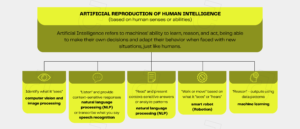Vehicles with no pedals, steering wheels, that drive automatically come to mind when we think of automated vehicles. We know that such a technology is under development and implementation in Brazil. This series of articles covers the key aspects of autonomous vehicles, including (a) how Artificial Intelligence works in autonomous vehicles and (b) relevant legal issues.
Improvements in Artificial Intelligence are creating a new reality for autonomous vehicles. This is because Artificial Intelligence enables us to replace human drivers for “artificial drivers”, making it possible to replace the capabilities and senses of a human driver with artificial intelligence.
Here is how Artificial Intelligence might work:

Artificial Intelligence enables the driving automation system to identify road signs, vehicles, and pedestrians. It also allows the car to “think” about what to do in different, expected, and unexpected situations, just as humans do. In this regard, the development of Artificial Intelligence is undoubtedly the path to achieving the dream of self-driving cars.
On the other hand, the replacement of a human driver, in whole or in part, poses certain legal challenges that need to be addressed. Without being exhaustive, those aspects include:
- The need to regulate autonomous cars comprehensively
- Consumer-related laws
- Civil liability aspects, including who is liable for damages caused by autonomous cars
- Telecommunications regulation regarding connected and online vehicles
- Transparency about how algorithms make decisions
- Data protection issues arising from the collection of drivers’ and third parties’ data
There are many innovations in the automobile market that result in different levels of driving automation. The Society of Automotive Engineers (SAE), in SAE J3016, outlined six levels of driving automation based on the level of human interference in driving tasks.
The SAE recently updated this standard in partnership with the International Organization for Standardization (ISO) to serve as a global guide.
Below we show how the levels of driving automation are classified:
Level 0 – No driving automation
The vehicle is fully conducted by a human driver. There is no driving automation, but this does not mean no technology.
The vehicle might have supporting features that provide warnings and momentary assistance to the driver, such as:
Blind spot warning
Automatic emergency braking
Lane departure warning
- Lane change alert: Issues an alert if there is a deviation without the turn
signal activated. - Blind spot warning: If it detects a vehicle on the blind spot area, it will warn the driver.
- Hill-start assist: Automatically engages the brakes to hold the vehicle in place for up to two seconds when on a hill.
- Cross-traffic alert: If traffic is detected behind the vehicle when slowly backing out of a parking spot or driveway, it will warn the driver.
- Frontal collision alert: Monitors speed and distance from the vehicle
ahead, and emits audible and visual alerts when detecting a possible collision. - Rear parking sensor: While slowly backing up, a series of beeps is emitted
when nearing an object. - Headlight height and intensity assistant: Automatically turns off the high beam upon detecting an approaching vehicle.
LEVEL 1 – Driver assistance
The main driving tasks depend on the driver.
The vehicle has one of the two (but not both) functionalities listed below
Frontal assistance: Adaptive cruise control
The driver sets the distance from the vehicle ahead. If it detects the car ahead is
slower, it automatically slows down the vehicle to avoid a collision.
Or
Lateral assistance: Lane centering
If the system detects that the driver is driving off the center of the traffic lane, it will bring the car back.
- Adaptative cruise control
- Active lane management: If the system detects an unintentional lane drift, it will alert the driver and correct the vehicle back into the lane.
- Emergency braking: Activates the brakes automatically when detecting risk of collision.
- Parking Assist: Controls the steering wheel when parking the vehicle.
- Automatic switching of headlamps:Regulates the intensity of headlights when detecting an approaching vehicle.
- Driver fatigue detector: When it detects signs of fatigue or attention fall, it activates alerts.
Level 2 – Partial driving automation
The vehicle controls both the steering wheel and the pedals simultaneously.
The driver needs to be alert to act in risky situations.
The car can drive without human interference for a few miles.
It combines the following technologies:
Adaptive cruise control.
and
Lane centering.
Level 3 – Conditional driving automation
The vehicle can make decisions independently.
The vehicle can travel without human interference for many miles, but the driver must be alert to act.
Traffic Jam Pilot
Recognizes, predicts, and makes decisions, applying a high level of control over acceleration,
braking, and steering.
Level 4 – High-level driving automation
The vehicle can operate and make decisions on its own.
The car can travel without human interference under limited conditions. It may have difficulty working in adverse weather conditions and on dangerous roads.
Pedals or steering wheel may or may not be installed
Level 5 – Full driving automation
The vehicle can operate, decide on its own, and even correct failures.
The car can travel without human interference under all conditions.
As a rule, there are no steering wheel or pedals. The passenger simply provides the coordinates to the destination.
Fully automated vehicles, without pedals, steering wheel or driver. Levels of driving automation that are yet to come
Para conferir o Infográfico explicativo sobre Carros Autônomos e baixar a cartilha completa, basta clicar nos botões abaixo.
 back
back



